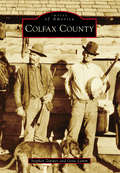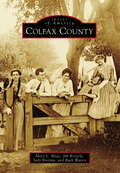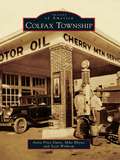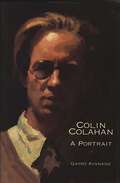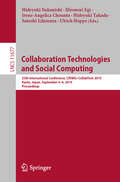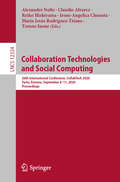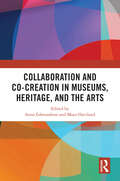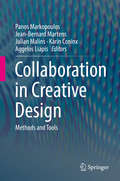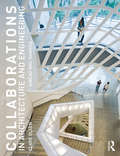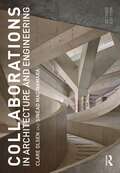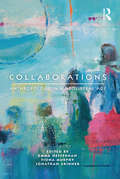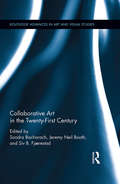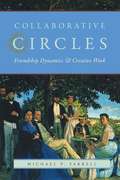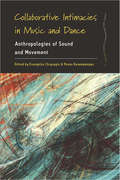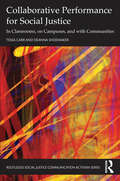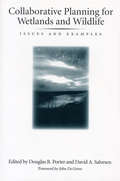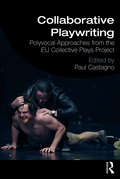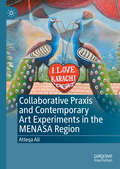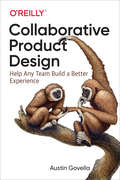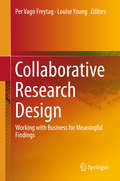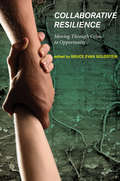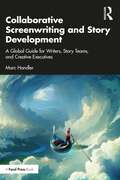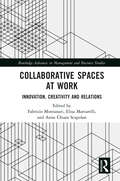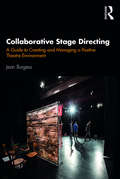- Table View
- List View
Colfax County
by Stephen Zimmer Gene LammIn 1841, Carlos Beaubien and Guadalupe Miranda received a grant of land from the governor of New Mexico in the northeastern part of the Mexican province. Frontier conditions prevented colonization of the grant until 1848, when Beaubien's son-in-law Lucien Maxwell led settlers from Taos to the Rayado River where it crossed the Santa Fe Trail. Maxwell's friend Kit Carson joined him the following year, and their ranch prospered in spite of frequent attacks by Jicarilla Apaches. Later, Maxwell moved north to the Cimarron River. Gold was discovered on the western part of the grant in 1866, and miners rushed to the diggings, establishing the town of Elizabethtown. It became the first seat of Colfax County in 1869. Maxwell sold the grant to foreign investors who organized the Maxwell Land Grant and Railway Company in 1870 and founded the town of Cimarron. The Santa Fe Railroad entered the county in 1879, which precipitated the creation of the towns of Raton and Springer and also fostered large-scale ranching, mining, and lumbering.
Colfax County (Images of America)
by Mary L. Maas Jim Krzycki Ruth Waters Judy BrezinaColfax County is unique with having two towns within its boundaries, Schuyler and Clarkson, plus four villages: Leigh, Howells, Richland, and Rogers. A number of farm precincts were once bustling communities, including Dublin, Heun, Maple Creek, Midland, Shell Creek, Tabor, and Wilson; now, most have only a church and/or cemetery to denote their sites. Schuyler is the county seat and can boast of having the first electric plant, water plant, and telephone exchange in the state. The Morman Trail, Oregon Trail, and Military Trail followed the banks of the Platte River and were utilized by troops and immigrants. Cattle herds from the Chisholm Trail were shipped from the Schuyler rail yards to markets in the East.
Colfax Township
by Anita Price Davis Scott Withrow Mike RhyneLocated at the Rutherford-Cleveland County line, Colfax Township was a response to the 1868 state mandate to divide North Carolina counties into townships. Colfax Township took its name from Schuyler Colfax, the 17th vice president of the United States (1869-1873). The 53.1 square miles of the township remain mainly rural, and most residents have lived here for five years or more. Such stability generates community pride and considerable participation in Big Days, the Colfax Free Fair, the Fiddler's Conventions, and other celebrations. The Colfax Museum reflects the interest in the area. Images of America: Colfax Township--a pictorial retrospective--celebrates the life and times of the area.
Colin Colahan: A Portrait
by Garry KinnaneColin Colahan was an Australian painter of outstanding ability and reputation who from the 1920s to the 1970s was remarkably productive. Colahan was one of the more brilliant pupils of the painter Max Meldrum. Identification with the unfashionable 'Meldrumites' is one explanation for Colahan's disappearance from the public gaze. The other has murkier origins in the still unsolved murder of his girlfriend, Mollie Dean, in 1930. There was nothing of substance to link Colahan to the brutal murder, but fevered public speculation cast a depressing shadow for many years and helped propel him to Europe in 1935. There he stayed for the rest of his long life. The story of Colahan's personal life is tantalising in itself—three marriages, five children, numerous lovers, beautiful houses in England and Italy, portrait painter of the rich and famous. It was an urbane life. He was a witty, charming, talented man. This intimate, engaging portrait is indeed most welcome, and will restore Colahan's life and work to its rightful place in the history of Australian art.
Collaboration Technologies and Social Computing: 25th International Conference, CRIWG+CollabTech 2019, Kyoto, Japan, September 4–6, 2019, Proceedings (Lecture Notes in Computer Science #11677)
by Ulrich Hoppe Hironori Egi Satoshi Ichimura Hideyuki Nakanishi Irene-Angelica Chounta Hideyuki TakadaThis book constitutes the refereed proceedings of the 25th International Conference, CRIWG+CollabTech 2019, held in Kyoto, Japan in September 2019. The 12 full papers presented in this book together with 8 work-in-progress papers were carefully reviewed and selected from 28 submissions, and the program also included an invited talk. This year presented a merger of the CRIWG and CollabTech conferences after having been jointly held since 2014. The papers published in this proceedings focus on innovative collaboration technologies and social computing.
Collaboration Technologies and Social Computing: 26th International Conference, CollabTech 2020, Tartu, Estonia, September 8–11, 2020, Proceedings (Lecture Notes in Computer Science #12324)
by Tomoo Inoue Irene-Angelica Chounta Alexander Nolte Claudio Alvarez Reiko Hishiyama María Jesús Rodríguez-TrianaThis book constitutes the proceedings of the 26th International Conference on Collaboration Technologies and Social Computing, CollabTech 2020. The conference was scheduled to take place in Tartu, Estonia, in September 2020. It was held virtually due to the COVID-19 pandemic. The 10 full and 5 work-in-progress papers presented in this volume were carefully reviewed and selected from 25 submissions.
Collaboration and Co-Creation in Museums, Heritage, and the Arts
by Anna Edmundson and Maya HavilandCollaboration and Co-Creation in Museums, Heritage, and the Arts examines collaborative practices in museums, heritage and the arts. It offers an interdisciplinary approach combining both practical and theoretical perspectives from leading scholars and practitioners to better understand and support co-creation and collaboration in the cultural sector.The volume is divided into five parts, offering contemporary perspectives on core topics and their interconnections. Themes include the politics of engagement, sharing and recentring authority, decolonising research and practice, facilitating partnerships, and structuring cocreation, and community empowerment. Through global case studies and theoretical analyses, contributors explore the challenges and opportunities of collaborative practices, exploring intersecting dynamics, motivations and constraints. The book examines various scales of co-creation, from interpersonal dynamics to community contexts and institutional transformations. The work contributes to ongoing discussions about the future of cultural institutions and the role of culture work in fostering perspectives and practices informed by diverse perspectives and generating multiple values. It emphasizes co-production as a crucial capability for the sector moving forward.Collaboration and Co-Creation in Museums, Heritage, and the Arts is essential for students, academics, communities and cultural practitioners interested in the complexities and rewards of collaborative work. It offers valuable insights into the theories and practices that shape collaborative projects across different cultural contexts and disciplines, making it an indispensable guide for anyone engaged in or studying the cultural sector.
Collaboration in Creative Design: Methods and Tools
by Panos Markopoulos Jean-Bernard Martens Julian Malins Karin Coninx Aggelos LiapisThis book presents a number of new methods, tools, andapproaches aimed to assist researchers and designers during the early stages ofthe design process, focusing on the need to approach the development of newinteractive products, systems and related services by closely observing theneeds of potential end-users through adopting a design thinking approach. A wide range of design approaches are explored, someemphasizing on the physicality of interaction and the products designed, othersexploring interactive design and the emerging userexperience (UX) with a focus on the value to the end-user. Contemporary designprocesses and the role of software tools to support design are also discussed. The researchers draw their expertise from a wide range of fields and it is thisinterdisciplinary approach which provides a unique perspective resulting in aflexible collection of methods that can be applied to a wide range ofdesign contexts. Interaction and UXdesigners and product design specialists will all find Collaboration in Creative Design an essential read.
Collaboration in Performance Practice: Premise, Workings and Failures
by Noyale Colin Stefanie SachsenmaierCollaboration between artists has been practised for centuries, yet over recent decades the act of collaborating has taken different meanings. This publication examines cultural, philosophical and political issues tied to specific instances of collaborative practice in the performing arts. Leading scholars and practitioners review historical developments of collaborative practice and reveal what it means to work together in creative contexts at the beginning of the twenty-first century. Key questions addressed include how artists are developing new ways of working together in response to contemporary economic trends, the significance of collaborating across culture and what opportunities are apparent when co-working between genres and disciplines. Noyale Colin and Stefanie Sachsenmaier present these perspectives in three thematic sections which interrogate the premises of collective intentions, the working strategies of current practitioners, as well as the role of failure and compromise in collaborative modes of creative work. This volume is an invaluable resource for scholars, practitioners and those interested in contemporary artistic methods of working.
Collaborations in Architecture and Engineering
by Clare Olsen Sinead Mac NamaraCollaborations in Architecture and Engineering focuses on team-building and problem-solving between architects and engineers to prepare you for working together in practice. It provides an overview and foundation for interdisciplinary collaboration so that you can create innovative proposals for optimization, performance, and aesthetic goals. It also shows you how to solve real-world problems and how to engage creatively with technological challenges so that you can be a productive member of any team. The authors, an architect and an engineer, share guidelines learned from their experiences and observations on how to insure productive communication, engage in interdisciplinary discussions, and establish common goals and values. Throughout the book are many case study examples of architect and engineer collaborations––such as those between SANAA and Mutsuro Sasaki, Foster + Partners and Buro Happold, Steven Holl and Guy Nordenson, and SHoP Architects and ARUP. The book also includes a discussion about integrated project delivery (IPD) contracts and administration, so you'll be ready for better integration.
Collaborations in Architecture and Engineering
by Clare Olsen Sinead Mac NamaraThis new edition of Collaborations in Architecture and Engineering explores how to effectively develop creative collaborations among architects and engineers. The authors, an architect and an engineer, share insights gained from their experiences and research on fostering productive communication, engaging in interdisciplinary discussions, and establishing common design goals. Together, they share the tools, methods, and best practices deployed by prominent innovative architects and engineers to provide readers with the key elements for success in interdisciplinary design collaborations. The book offers engaging stories about prominent architect and engineer collaborations––such as those between SANAA and Sasaki and Partners, Adjaye Associates and Silman, Grafton Architects and AKT II, Studio Gang and Arup, Foster + Partners and Buro Happold, Steven Holl Architects and Guy Nordenson and Associates, and among the engineers and architects at SOM. In the second edition, the newly added case studies showcase extraordinary buildings across the globe at a range of scales and typologies, tracing the facets of high-quality collaborations. Through the examples of these remarkable synergies, readers gain insights into innovative design processes that address complex challenges in the built environment. The second edition of Collaborations in Architecture and Engineering is a terrific sourcebook for students, educators, and professionals interested in integrative design practice among the disciplines.
Collaborations: Anthropology in a Neoliberal Age (Criminal Practice Ser.)
by Jonathan Skinner Fiona Murphy Emma HeffernanCollaborations responds to the growing pressure on the humanities and social sciences to justify their impact and utility after cuts in public spending, and the introduction of neoliberal values into academia. Arguing ‘in defense of’ anthropology, the editors demonstrate the continued importance of the discipline and reveal how it contributes towards solving major problems in contemporary society. They also illustrate how anthropology can not only survive but thrive under these conditions. Moreover, Collaborations shows that collaboration with other disciplines is the key to anthropology’s long-term sustainability and survival, and explores the challenges that interdisciplinary work presents. The book is divided into two parts: Anthropology and Academia, and Anthropology in Practice. The first part features examples from anthropologists working in academic settings which range from the life, behavioural and social sciences to the humanities, arts and business. The second part highlights detailed ethnographic contributions on topics such as peace negotiations, asylum seekers, prostitution and autism. Collaborations is an important read for students, scholars and professional and applied anthropologists as it explores how anthropology can remain relevant in the contemporary world and how to prevent it from becoming an increasingly isolated and marginalized discipline.
Collaborative Art in the Twenty-First Century (Routledge Advances in Art and Visual Studies)
by Sondra Bacharach Siv B. Fjærestad Jeremy Neil BoothCollaboration in the arts is no longer a conscious choice to make a deliberate artistic statement, but instead a necessity of artistic survival. In today’s hybrid world of virtual mobility, collaboration decentralizes creative strategies, enabling artists to carve new territories and maintain practice-based autonomy in an increasingly commercial and saturated art world. Collaboration now transforms not only artistic practices but also the development of cultural institutions, communities and personal lifestyles. This book explores why collaboration has become so integrated into a greater understanding of creative artistic practice. It draws on an emerging generation of contributors—from the arts, art history, sociology, political science, and philosophy—to engage directly with the diverse and interdisciplinary nature of collaborative practice of the future.
Collaborative Circles: Friendship Dynamics and Creative Work
by Michael P. FarrellMany artists, writers, and other creative people do their best work when collaborating within a circle of like-minded friends. Experimenting together and challenging one another, they develop the courage to rebel against the established traditions in their field. Out of their discussions they develop a new, shared vision that guides their work even when they work alone. In a unique study that will become a rich source of ideas for professionals and anyone interested in fostering creative work in the arts and sciences, Michael P. Farrell looks at the group dynamics in six collaborative circles: the French Impressionists; Sigmund Freud and his friends; C. S. Lewis, J. R. R. Tolkien, and the Inklings; social reformers Elizabeth Cady Stanton and Susan B. Anthony; the Fugitive poets; and the writers Joseph Conrad and Ford Maddox Ford. He demonstrates how the unusual interactions in these collaborative circles drew out the creativity in each member. Farrell also presents vivid narrative accounts of the roles played by the members of each circle. He considers how working in such circles sustains the motivation of each member to do creative work; how collaborative circles shape the individual styles of the persons within them; how leadership roles and interpersonal relationships change as circles develop; and why some circles flourish while others flounder.
Collaborative Intimacies in Music and Dance: Anthropologies of Sound and Movement (Dance and Performance Studies #10)
by Evangelos Chrysagis Panas KarampampasAcross spatial, bodily, and ethical domains, music and dance both emerge from and give rise to intimate collaboration. This theoretically rich collection takes an ethnographic approach to understanding the collective dimension of sound and movement in everyday life, drawing on genres and practices in contexts as diverse as Japanese shakuhachi playing, Peruvian huayno, and the Greek goth scene. Highlighting the sheer physicality of the ethnographic encounter, as well as the forms of sociality that gradually emerge between self and other, each contribution demonstrates how dance and music open up pathways and give shape to life trajectories that are neither predetermined nor teleological, but generative.
Collaborative Performance for Social Justice: In Classrooms, on Campuses, and with Communities (Routledge Social Justice Communication Activism Series)
by Tessa Carr Deanna ShoemakerThis engaging book offers a broad spectrum of collaborative and accessible performance-based practices that promote social justice within college classrooms, rehearsal spaces, campus stages and local communities.Performance is an inherently collective and embodied endeavor. As a form of communication activism, performance also serves as a powerful mode of teaching and learning that demands equitable relationships and mutually established group norms that offer all a seat at the table. Informed by intersectional feminist and antiracist theories, the authors present collaborative performance case studies, ranging from interventions into local histories of oppression to creative protests of campus and cultural practices, to staged interruptions of social discourses and representational systems that perpetuate structural inequities. Illustrating the multiple possibilities of performance, the book offers adaptable tools, evocative stories, and vivid examples from diverse bodies of work. This engaged scholarship is committed to honoring multiple forms of knowledge, acknowledging and building the capacities of individuals and organizations, identifying and developing more spaces for critical dialogue, and envisioning and performing a more socially just world.This book is essential reading for scholars and practitioners of communication, theater, performance studies, arts-based education, and social justice activism.
Collaborative Planning for Wetlands and Wildlife: Issues And Examples
by Douglas R. Porter Leah Haygood Mary Jean Matthews Mark B. Adams Ed Finder David SalvesenCollaborative Planning for Wetlands and Wildlife presents numerous case studies that demonstrate how different communities have creatively reconciled problems between developers and environmentalists. It answers questions asked by regulators, environmentalists, and developers who seek practical alternatives to the existing case-by-case permitting process, and offers valuable lessons from past and ongoing areawide planning efforts.
Collaborative Playwriting: Polyvocal Approaches from the EU Collective Plays Project
by Paul CastagnoIn Collaborative Playwriting, five collectively written plays apply polyvocal methods in which clash and frisson replace synthesis, a dialogic approach to collective writing that has never before been articulated or documented. Based on the EU Collective Plays Project, this collection of plays showcases each voice in dialogic tension and in relation to the other voices of the text, offering an entirely novel approach to new play development that challenges the single (and privileged) authorial voice. Castagno’s case-study approach provides detailed commentary on each of the various experimental methods, exploring the plays’ processes in detail. The book offers an evolutionary path forward in how to develop new work, thus encouraging and promoting the writing of collective, hybrid plays as having profound benefits for all playwrights. The ground breaking approaches to playmaking in Collaborative Playwriting will appeal to playwriting programs, instructors, academics, professional playwrights, theaters and new play development programs; as well as courses in gender LGBTQ studies, script analysis, dramaturgy and dramatic literature across the theater studies curricula.
Collaborative Praxis and Contemporary Art Experiments in the MENASA Region
by Atteqa AliThis book examines the ways in which artists and arts organizations today forge collaborative, socially engaged situations that involve non-professionals in the process of making art, often over a period of time, through creating opportunities to examine collective concerns and needs. Collaborative art praxis is gaining prominence in the Middle East, North Africa, and South Asia (MENASA) region. This is a discursive method that is experimental, with results that often expand the notions of what art is—and how it can be produced. After an introduction to global approaches to such a practice, Ali examines the foundation of contemporary art in the MENASA that is linked to a longer history of colonialism. The book analyzes artist-led initiatives and community-based organizations through themes including relational aesthetics, war and violence, blight in marginalized places around the world, in addition to questions associated with art and its value in the fields of global contemporary art and society.
Collaborative Product Design: Help Any Team Build a Better Experience
by Austin GovellaYou can launch a new app or website in days by piecing together frameworks and hosting on AWS. Implementation is no longer the problem. But that speed to market just makes it tougher to confirm that your team is actually building the right product.Ideal for agile teams and lean organizations, this guide includes 11 practical tools to help you collaborate on strategy, user research, and UX. Hundreds of real-world tips help you facilitate productive meetings and create good collaboration habits. Designers, developers, and product owners will learn how to build better products much faster than before.Topics include:Foundations for collaboration and facilitation: Learn how to work better together with your team, stakeholders, and clientsProject strategy: Help teams align with shared goals and visionUser research and personas: Identify and understand your users and share that vision with the broader organizationJourney maps: Build better touchpoints that improve conversion and retentionInterfaces and prototypes: Rightsize sketches and wireframes so you can test and iterate quickly
Collaborative Research Design: Working with Business for Meaningful Findings
by Louise Young Per Vagn FreytagThis book articulates and interconnects a range of research methods for the investigation of business management processes. It introduces new directions that both recognise the business community as stakeholders in the research process and seek to include them in that process. The book presents a range of contemporary research methods with particular focus on those that allow insights into business managers' thoughts and behaviours. It includes fresh views on traditional research designs, for example new approaches to using literature reviews, experiments, interviews and observation studies. It also considers cutting-edge research methods, such as the use of vignettes, workshops, improvisation and theatre, as well as computer-based simulation. In addition to discussing new approaches to data capture and data generation, it presents new methods of data analysis by considering various forms of models and modelling, new forms of computer-aided text analysis and innovative approaches to data display. Finally, the book provides a link between the philosophical underpinnings of research and the different research methods presented. This is often neglected but undertaking the knowledge-generating journey that is research includes having a view on reality and marrying this to beliefs about how the reality to be investigated can be best expedited.
Collaborative Resilience: Moving Through Crisis to Opportunity
by Bruce Evan GoldsteinCase studies and analyses investigate how collaborative response to crisis can enhance social-ecological resilience and promote community reinvention.Crisis—whether natural disaster, technological failure, economic collapse, or shocking acts of violence—can offer opportunities for collaboration, consensus building, and transformative social change. Communities often experience a surge of collective energy and purpose in the aftermath of crisis. Rather than rely on government and private-sector efforts to deal with crises through prevention and mitigation, we can harness post-crisis forces for recovery and change through innovative collaborative planning.Drawing on recent work in the fields of planning and natural resource management, this book examines a range of efforts to enhance resilience through collaboration, describing communities that have survived and even thrived by building trust and interdependence. These collaborative efforts include environmental assessment methods in Cozumel, Mexico; the governance of a "climate protected community" in the Blackfoot Valley of Montana; fisheries management in Southeast Asia's Mekong region; and the restoration of natural fire regimes in U.S. forests. In addition to describing the many forms that collaboration can take—including consensus processes, learning networks, and truth and reconciliation commissions—the authors argue that collaborative resilience requires redefining the idea of resilience itself. A resilient system is not just discovered through good science; it emerges as a community debates and defines ecological and social features of the system and appropriate scales of activity. Poised between collaborative practice and resilience analysis, collaborative resilience is both a process and an outcome of collective engagement with social-ecological complexity.
Collaborative Screenwriting and Story Development: A Global Guide for Writers, Story Teams, and Creative Executives
by Marc HandlerThis is a comprehensive guide to teach writing and story development from a collaborative global perspective. This book teaches writers how to take full advantage of emerging opportunities, both locally and globally. With an increasing number of international co-productions and many screenwriters now working collaboratively in writers rooms and development groups, author Marc Handler explains how to work cooperatively with others to break stories, plan seasons, create characters, and build series. To succeed, readers will learn how to give and receive feedback effectively, adapt to the style and constraints of executives and brands, and contribute to the team building process, all within an increasingly global media industry that is in constant flux. This book will help readers develop a global perspective, ensuring that they are prepared for new opportunities as they arise. Marc Handler provides cultural insight and understanding as he describes the fundamentals as well as advanced story skills. This book is essential reading for students taking classes such as Screenwriting Fundamentals, Writing for Film and TV, Introduction to Television Writing, and Advanced Screenwriting, as well as aspiring and early career screenwriters, showrunners, producers, and creative executives.
Collaborative Spaces at Work: Innovation, Creativity and Relations (Routledge Advances in Management and Business Studies)
by Fabrizio Montanari Elisa Mattarelli Anna Chiara ScapolanCollaborative spaces are more than physical locations of work and production. They present strong identities centered on collaboration, exchange, sense of community, and co-creation, which are expected to create a physical and social atmosphere that facilitates positive social interaction, knowledge sharing, and information exchange. This book explores the complex experiences and social dynamics that emerge within and between collaborative spaces and how they impact, sometimes unexpectedly, on creativity and innovation. Collaborative Spaces at Work is timely and relevant: it will address the gap in critical understandings of the role and outcomes of collaborative spaces. Advancing the debate beyond regional development rhetoric, the book will investigate, through various empirical studies, if and how collaborative spaces do actually support innovation and the generation of new ideas, products, and processes. The book is intended as a primary reference in creativity and innovation, workspaces, knowledge and creative workers, and urban studies. Given its short chapters and strong empirical orientation, it will also appeal to policy makers interested in urban regeneration, sustaining innovation, and social and economic development, and to managers of both collaborative spaces and companies who want to foster creativity within larger organizations. It can also serve as a textbook in master’s degrees and PhD courses on innovation and creativity, public management, urban studies, management of work, and labor relations.
Collaborative Stage Directing: A Guide to Creating and Managing a Positive Theatre Environment
by Jean BurgessCollaborative Stage Directing: A Guide to Creating and Managing a Positive Theatre Environment focuses on the director’s collaboration with actors and the creative team, and the importance of communication and leadership skills to create and manage a healthy working environment. Speaking directly to the student, this compact resource walks the aspiring director through basic principles of group dynamics, active listening, open-ended questioning, brainstorming, and motivational leadership, supported by examples and case studies offered by current professional and academic directors. With a focus on preparing the student director for resume-building opportunities beyond the studio lab, Collaborative Stage Directing challenges readers with reflective activities, a series of guiding questions to apply to three short plays, and an extensive checklist to assist them with independent directing projects. As an easy-to-use resource, Collaborative Stage Directing works as a supplement to a classic directing text or as a stand-alone guide.
